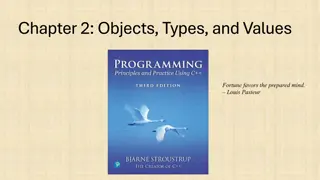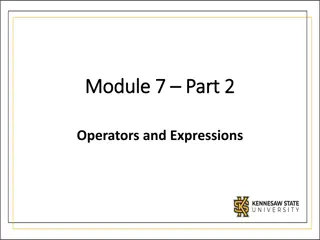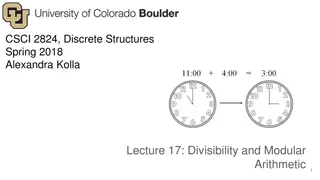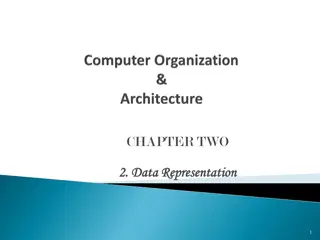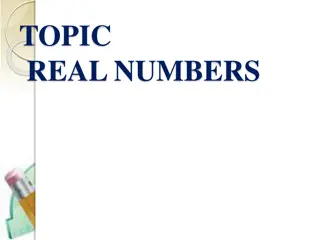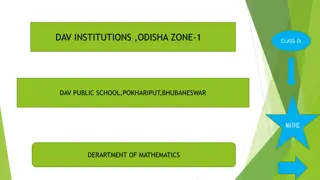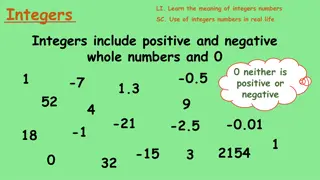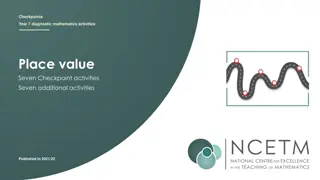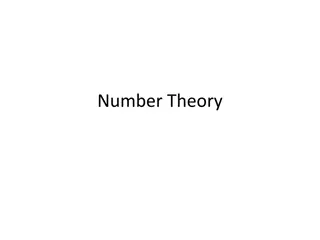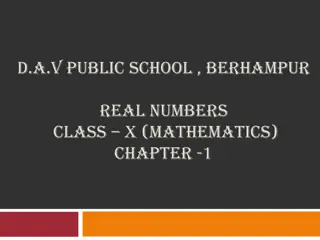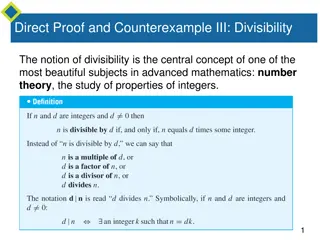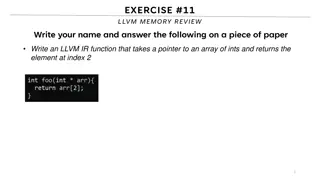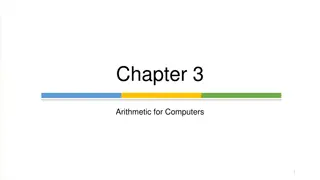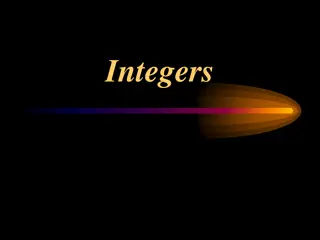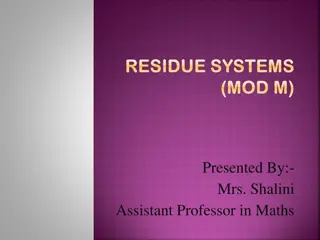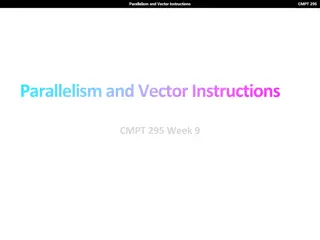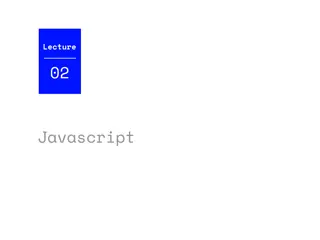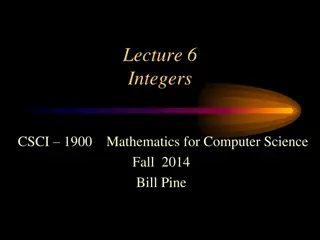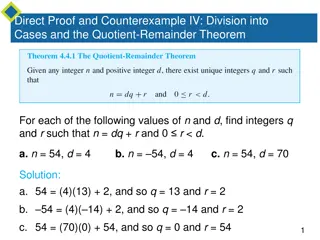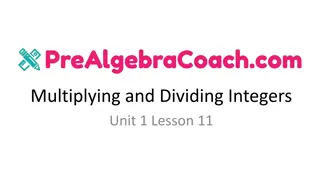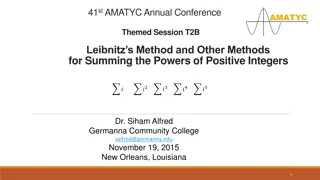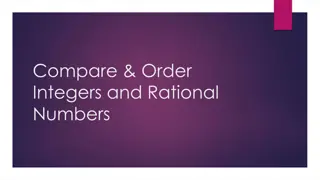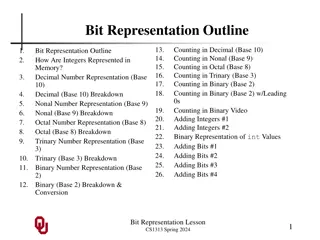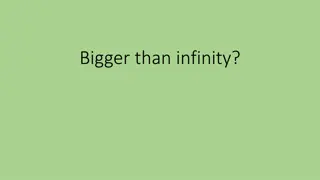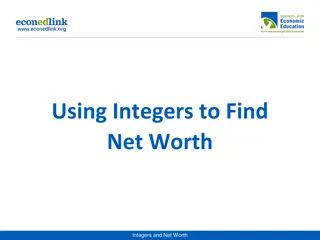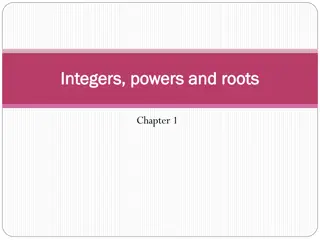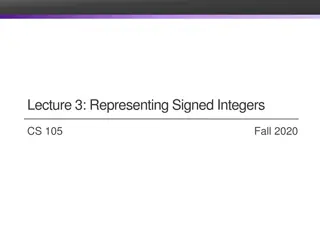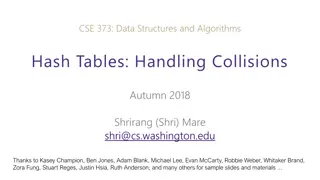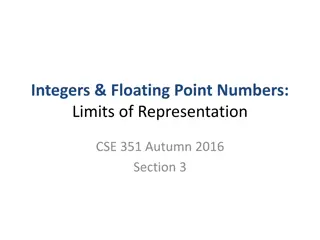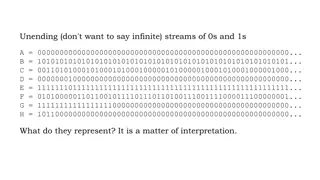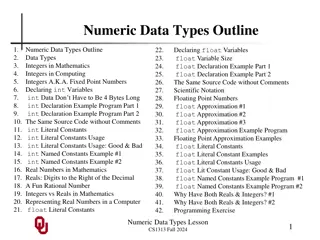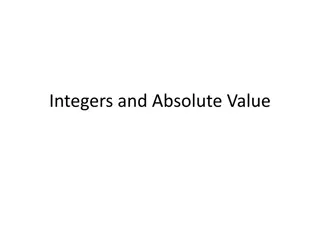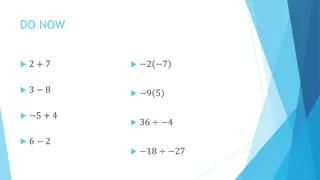Understanding Signed Integers and Addition in Computational Systems
Dive into the world of signed integers, extensions, truncations, and addition in computer science with a focus on how negative values are represented and operated on. Explore concepts like sign-magnitude and two's complement representations, uncovering the intricacies of handling integers in computa
5 views • 25 slides
Understanding Objects, Types, and Values in Programming
Programming tasks often revolve around data manipulation. This chapter delves into input and output processes, variables, types, and type safety in programming. Exploring concepts like strings, integers, objects, and type declarations, it emphasizes the importance of being mindful of data handling m
1 views • 29 slides
Understanding Math Operators and Expressions in Python and Java
Explore the operations like addition, multiplication, division, power, and more in Python and Java. Learn how these operations work with integers, floats, and strings to enhance your understanding of mathematical expressions in programming.
1 views • 13 slides
Understanding Divisibility and Modular Arithmetic in Discrete Structures
This lecture discusses the concepts of divisibility and modular arithmetic in the context of discrete structures. It covers definitions, notation, and examples of divisibility by integers, including proving properties such as the divisibility of products and consecutive integers. Through practical e
1 views • 43 slides
Understanding Number Systems in Computer Science
Exploring how modern computer systems represent numeric values using various numbering systems such as binary, decimal, and hexadecimal. Discover the fundamentals of each system, their importance in digital systems, and methods for representing negative integers.
0 views • 17 slides
Exploring Real Numbers and Number Systems
Dive into the world of real numbers with topics ranging from the definition of real numbers to Euclid's Division Algorithm and the Fundamental Theorem of Arithmetic. Discover the properties of rational and irrational numbers, learn to find the highest common factor (HCF) and least common multiple (L
0 views • 37 slides
Understanding Arithmetic Operators in C Programming
C programming language provides various arithmetic operators such as addition, subtraction, multiplication, division, and modulo division. Integer division truncates any fractional part, while modulo division produces the remainder of an integer division. When operands in an arithmetic expression ar
1 views • 18 slides
Understanding Rational and Irrational Numbers in Mathematics
Explore the concept of rational and irrational numbers in mathematics through defining, distinguishing, computing, representing, and rationalizing these types of numbers. Learn about natural numbers, whole numbers, integers, rational numbers, and irrational numbers with clear examples. Answer common
1 views • 48 slides
Understanding Integers: Real-life Applications and Examples
Explore the world of integers, encompassing both positive and negative whole numbers along with zero. Discover practical instances where integers are encountered, such as temperature readings, financial transactions, and positional indicators like floors in a building. Dive into scenarios where nega
0 views • 34 slides
Understanding Instruction Set Architecture and Data Types in Computer Systems
In computer architecture, the Instruction Set Architecture (ISA) level is crucial in defining how a processor executes instructions. This includes the formal defining documents, memory models, registers, and various data types that can be supported. The ISA level specifies the capabilities of a proc
2 views • 13 slides
Mathematics Checkpoints and Activities for Year 7 Students
Explore a series of mathematics checkpoints and activities designed for Year 7 students, focusing on place value, comparing representations, calculations, and understanding inequalities. Engage in tasks such as arranging digits, working with multiples of 3, and understanding the value of digits in d
0 views • 22 slides
Understanding Number Theory Fundamentals
Explore the fascinating world of number theory covering ancient problems like factoring and primality testing. Learn about prime numbers, prime factorization, primality testing, and basic arithmetic operations. Discover modular arithmetic and its applications in dealing with a restricted range of nu
0 views • 52 slides
Real Numbers: Classification, Operations, and Examples
Real numbers encompass a wide range of mathematical entities, including natural numbers, whole numbers, integers, fractions, rational numbers, and irrational numbers. This chapter delves into the classification of real numbers, Euclid's Division Lemma and Algorithm, finding HCF and LCM using these m
4 views • 15 slides
Exploring Divisibility in Number Theory
Delve into the fascinating world of number theory, where the concept of divisibility plays a central role. Learn about the properties and applications of divisibility in integer mathematics through direct proofs, counterexamples, and algebraic expressions. Discover the transitivity of divisibility a
0 views • 15 slides
Understanding Rational Numbers: A Comprehensive Overview
Discover the world of numbers with this comprehensive guide on different types of numbers, focusing on rational numbers. Learn about natural numbers, whole numbers, integers, and how rational numbers are represented on a number line. Dive into the properties of rational numbers and explore the conce
2 views • 19 slides
LLVM Memory Review and Function Example
In this exercise, an LLVM IR function is created to extract the element at index 2 from a pointer to an array of integers. The concept of named memory in LLVM is reviewed, distinguishing between local, global, and constant memory declarations. Additionally, memory access operations like store, load,
2 views • 18 slides
Understanding Arithmetic Operations for Computers
The chapter delves into the fundamentals of arithmetic for computers, covering operations on integers, dealing with overflow, handling floating-point real numbers, and more. It explores addition, subtraction, multiplication, and division in detail, showcasing examples and techniques for efficient co
4 views • 18 slides
Understanding Operations with Integers
Integers are whole numbers and their opposites. Learn about addition, subtraction, multiplication, and division of integers. Follow specific rules based on the signs of the numbers involved to correctly perform operations. This educational presentation provides clear explanations and visual examples
0 views • 13 slides
Understanding Residue Systems and Euler's Phi Function in Mathematics
Residue Systems, also known as Reduced Residue Systems, play a significant role in number theory. They involve concepts like the Euler Phi Function, which counts integers relatively prime to a given number. Complete Residue Systems and their properties are explored, highlighting the least non-negati
3 views • 11 slides
Understanding Parallelism and Vector Instructions in CMPT 295
Delve into the world of parallelism and vector instructions in CMPT 295 as you explore fixed-length vector intrinsics, RISC-V concepts, computer programming fundamentals, processor execution processes, scalar and vector loops, and more. Discover the intricacies of memory, data arrays, structs, integ
1 views • 45 slides
Understanding Integer Multiplication with Examples
Explore the concept of multiplying integers with examples of same and different signs. Learn how the product changes based on the signs of the numbers involved. Step-by-step examples demonstrate how to determine whether the result will be positive or negative. Additionally, engage in practical scena
2 views • 14 slides
Introduction to Basic Python Datatypes & Software Development
Explore the fundamental concepts of Python programming, including basic datatypes such as integers, floats, and booleans. Learn about software development, Python scripts, printing messages, user inputs, and more. Get started with Python using online IDEs like repl.it and delve into writing your fir
2 views • 29 slides
Understanding Variables and Control Structures in JavaScript
Introduction to JavaScript variables including integers, floats, strings, booleans, and arrays. Learn about control structures like if-else statements, comparison operators, and loops. Practice examples provided for better understanding.
0 views • 38 slides
Understanding Euclid's Algorithm: An Ancient Approach to Finding Greatest Common Divisors
Euclid's Algorithm, dating back 2500 years, offers a simpler method to find the greatest common divisor (gcd) of two non-negative integers compared to traditional factorization. By iteratively applying a rule based on the gcd of remainders, it efficiently computes gcd values. The basis of the algori
0 views • 15 slides
Exploring Integers, Divisibility, and Prime Numbers in Mathematics for Computer Science
Discover the fundamental concepts of integers, divisibility, remainder theorem, prime numbers, and their applications in computer science. Learn about integer division, examples of remainders, properties of divisibility, and the significance of prime numbers in cryptography. Explore the interplay be
0 views • 26 slides
Understanding Integer Division, Modulus, and Parity
Explore the concepts of integer division, modulus, and the parity of integers through the quotient-remainder theorem. Learn how to compute div and mod manually and understand the representation of integers as even or odd. Discover how these principles apply in computer languages and the unique prope
0 views • 18 slides
Understanding Multiplying and Dividing Integers Unit 1 Lesson 11
In this lesson on multiplying and dividing integers, students will learn how to apply rules for multiplication, including when integers have the same or different signs. Key vocabulary includes integers, negative numbers, and positive numbers. Sample problems are provided to practice multiplying int
0 views • 51 slides
Exploring Sums of Powers of Positive Integers Through Leibnitz's Method
Students are introduced to the computation of sums of powers of positive integers through Leibnitz's Method and other techniques in the context of finding areas under curves and exploring integration. The presentation delves into the origins of these formulas and their computation, reflecting on the
0 views • 24 slides
Understanding Integers and Rational Numbers Through Examples
Explore a series of questions that involve comparing and ordering integers and rational numbers, along with practical scenarios like determining temperatures and organizing prices. Test your knowledge on identifying rational numbers, understanding integer properties, and arranging numbers in sequenc
0 views • 16 slides
Understanding Integer Representation in Computer Memory
Explore the binary representation of integers in computer memory, covering decimal, nonal, octal, trinary, and binary numbering systems. Learn how integers are stored using sequences of bits and decipher the breakdown of numbers in different bases. Discover the Arabic digits in decimal representatio
0 views • 26 slides
Exploring Infinity: From Countable Integers to the Unbounded Real Numbers
Delve into the realm of infinity, where the concept transcends our finite understanding. Discover how the set of positive integers, even numbers, all integers, positive rational numbers, and real numbers each showcase a distinct level of infinity. Explore the notion of cardinality, bridging the gap
0 views • 9 slides
Understanding Net Worth: Integers and Financial Assets
Learn about net worth, liabilities, and assets by exploring how integers are used to determine the financial standing of individuals. Discover the concepts of liabilities, responsibilities, and assets through real-life examples of notable personalities. Dive into calculations and understand how net
0 views • 18 slides
Understanding Integers, Powers, and Roots: A Comprehensive Guide
Explore the world of integers, powers, and roots in this educational chapter. Learn how to multiply and divide integers, calculate squares and square roots, understand laws of indices, and master the order of operations. Discover concepts like LCM, HCF, prime factorization, natural and rational numb
0 views • 24 slides
Understanding Signed Integer Representations in Computer Science
Explore various methods of representing signed integers in computer memory, including sign-magnitude, excess-K, and two's complement. Learn about binary numbers, important signed values, and how to perform calculations with signed integers. Delve into exercises to solidify your understanding.
0 views • 31 slides
Understanding Hash Tables and Handling Collisions
This content covers the concepts of hash tables, handling collisions, and efficient implementation of dictionary operations. It explores methods like direct-access tables, converting keys to non-negative integers, and using functions to work with non-integer keys. The discussion includes approaches
0 views • 32 slides
Understanding Integer and Floating Point Number Representations
Exploring the limitations and design decisions behind representing integers and floating point numbers in memory. Learn about unsigned and signed integers, two's complement, as well as key values and concepts to remember. Delve into the vision behind floating point numbers and their representation f
0 views • 20 slides
Understanding Binary Numbers and Their Representation in Mathematics
Explore the world of binary numbers through a series of infinite 0s and 1s, representing integers and real numbers between 0 and 1. Dive into the interpretation of these binary sequences as natural numbers, integers, and fractions, shedding light on the concepts of trans-finite numbers and their pla
0 views • 16 slides
Understanding Numeric Data Types in Programming
Exploring the world of numeric data types, this content delves into the concepts of integers and real numbers in mathematics as well as their representation in computing. It covers the use of literal constants, named constants, and the differences between integers and real numbers. The content also
0 views • 42 slides
Understanding Integers and Absolute Value Concepts
This content covers the definitions and examples of integers, integers on a number line, opposites of numbers, absolute value, and real-life applications related to freezing points. Explore the concept of integers, their representation on a number line, absolute value calculations, and practical sce
0 views • 9 slides
Mathematics Classroom Resources and Activities
Dive into an array of resources and activities for the math classroom, including distributing workbooks, reviewing integer rules, practicing adding and subtracting integers, and mastering multiplying and dividing integers. Engage students with classwork packets and homework assignments to reinforce
0 views • 8 slides

